The amyloid precursor protein/protease nexin 2 Kunitz inhibitor domain is a highly specific substrate of mesotrypsin
- PMID: 19920152
- PMCID: PMC2804352
- DOI: 10.1074/jbc.M109.057216
The amyloid precursor protein/protease nexin 2 Kunitz inhibitor domain is a highly specific substrate of mesotrypsin
Abstract
The amyloid precursor protein (APP) is a ubiquitously expressed transmembrane adhesion protein and the progenitor of amyloid-beta peptides. The major splice isoforms of APP expressed by most tissues contain a Kunitz protease inhibitor domain; secreted APP containing this domain is also known as protease nexin 2 and potently inhibits serine proteases, including trypsin and coagulation factors. The atypical human trypsin isoform mesotrypsin is resistant to inhibition by most protein protease inhibitors and cleaves some inhibitors at a substantially accelerated rate. Here, in a proteomic screen to identify potential physiological substrates of mesotrypsin, we find that APP/protease nexin 2 is selectively cleaved by mesotrypsin within the Kunitz protease inhibitor domain. In studies employing the recombinant Kunitz domain of APP (APPI), we show that mesotrypsin cleaves selectively at the Arg(15)-Ala(16) reactive site bond, with kinetic constants approaching those of other proteases toward highly specific protein substrates. Finally, we show that cleavage of APPI compromises its inhibition of other serine proteases, including cationic trypsin and factor XIa, by 2 orders of magnitude. Because APP/protease nexin 2 and mesotrypsin are coexpressed in a number of tissues, we suggest that processing by mesotrypsin may ablate the protease inhibitory function of APP/protease nexin 2 in vivo and may also modulate other activities of APP/protease nexin 2 that involve the Kunitz domain.
Figures
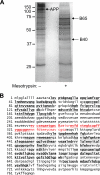
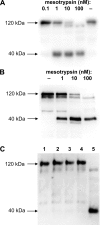
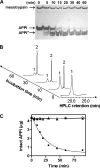


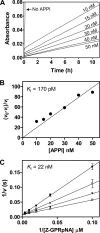
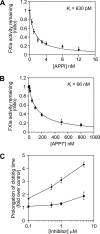
Similar articles
-
Sequence and conformational specificity in substrate recognition: several human Kunitz protease inhibitor domains are specific substrates of mesotrypsin.J Biol Chem. 2014 Nov 21;289(47):32783-97. doi: 10.1074/jbc.M114.609560. Epub 2014 Oct 9. J Biol Chem. 2014. PMID: 25301953 Free PMC article.
-
Disulfide engineering of human Kunitz-type serine protease inhibitors enhances proteolytic stability and target affinity toward mesotrypsin.J Biol Chem. 2019 Mar 29;294(13):5105-5120. doi: 10.1074/jbc.RA118.007292. Epub 2019 Jan 30. J Biol Chem. 2019. PMID: 30700553 Free PMC article.
-
Protease nexin II interactions with coagulation factor XIa are contained within the Kunitz protease inhibitor domain of protease nexin II and the factor XIa catalytic domain.Biochemistry. 2000 Apr 25;39(16):4769-77. doi: 10.1021/bi9925468. Biochemistry. 2000. PMID: 10769134
-
Platelet protease nexin-2/amyloid beta-protein precursor. Possible pathologic and physiologic functions.Ann N Y Acad Sci. 1991;640:140-4. doi: 10.1111/j.1749-6632.1991.tb00205.x. Ann N Y Acad Sci. 1991. PMID: 1776731 Review.
-
Potential role of protease nexin-2/amyloid beta-protein precursor as a cerebral anticoagulant.Ann N Y Acad Sci. 1992 Dec 31;674:243-52. doi: 10.1111/j.1749-6632.1992.tb27493.x. Ann N Y Acad Sci. 1992. PMID: 1288367 Review.
Cited by
-
Presence versus absence of hydrogen bond donor Tyr-39 influences interactions of cationic trypsin and mesotrypsin with protein protease inhibitors.Protein Sci. 2012 Aug;21(8):1103-12. doi: 10.1002/pro.2097. Epub 2012 Jun 25. Protein Sci. 2012. PMID: 22610453 Free PMC article.
-
Mesotrypsin Has Evolved Four Unique Residues to Cleave Trypsin Inhibitors as Substrates.J Biol Chem. 2015 Aug 28;290(35):21523-35. doi: 10.1074/jbc.M115.662429. Epub 2015 Jul 14. J Biol Chem. 2015. PMID: 26175157 Free PMC article.
-
Climbing Up and Down Binding Landscapes through Deep Mutational Scanning of Three Homologous Protein-Protein Complexes.J Am Chem Soc. 2021 Oct 20;143(41):17261-17275. doi: 10.1021/jacs.1c08707. Epub 2021 Oct 5. J Am Chem Soc. 2021. PMID: 34609866 Free PMC article.
-
UHRF1/DNMT1-MZF1 axis-modulated intragenic site-specific CpGI methylation confers divergent expression and opposing functions of PRSS3 isoforms in lung cancer.Acta Pharm Sin B. 2023 May;13(5):2086-2106. doi: 10.1016/j.apsb.2023.02.015. Epub 2023 Feb 24. Acta Pharm Sin B. 2023. PMID: 37250150 Free PMC article.
-
Mesotrypsin Signature Mutation in a Chymotrypsin C (CTRC) Variant Associated with Chronic Pancreatitis.J Biol Chem. 2015 Jul 10;290(28):17282-92. doi: 10.1074/jbc.M114.618439. Epub 2015 May 26. J Biol Chem. 2015. PMID: 26013824 Free PMC article.
References
-
- Chen J. M., Ferec C. (2000) Pancreas 21, 57–62 - PubMed
-
- Ge X., Yamamoto S., Tsutsumi S., Midorikawa Y., Ihara S., Wang S. M., Aburatani H. (2005) Genomics 86, 127–141 - PubMed
-
- Yanai I., Benjamin H., Shmoish M., Chalifa-Caspi V., Shklar M., Ophir R., Bar-Even A., Horn-Saban S., Safran M., Domany E., Lancet D., Shmueli O. (2005) Bioinformatics 21, 650–659 - PubMed
-
- Diederichs S., Bulk E., Steffen B., Ji P., Tickenbrock L., Lang K., Zänker K. S., Metzger R., Schneider P. M., Gerke V., Thomas M., Berdel W. E., Serve H., Müller-Tidow C. (2004) Cancer Res. 64, 5564–5569 - PubMed
Publication types
MeSH terms
Substances
Grants and funding
LinkOut - more resources
Full Text Sources
Other Literature Sources
Medical

